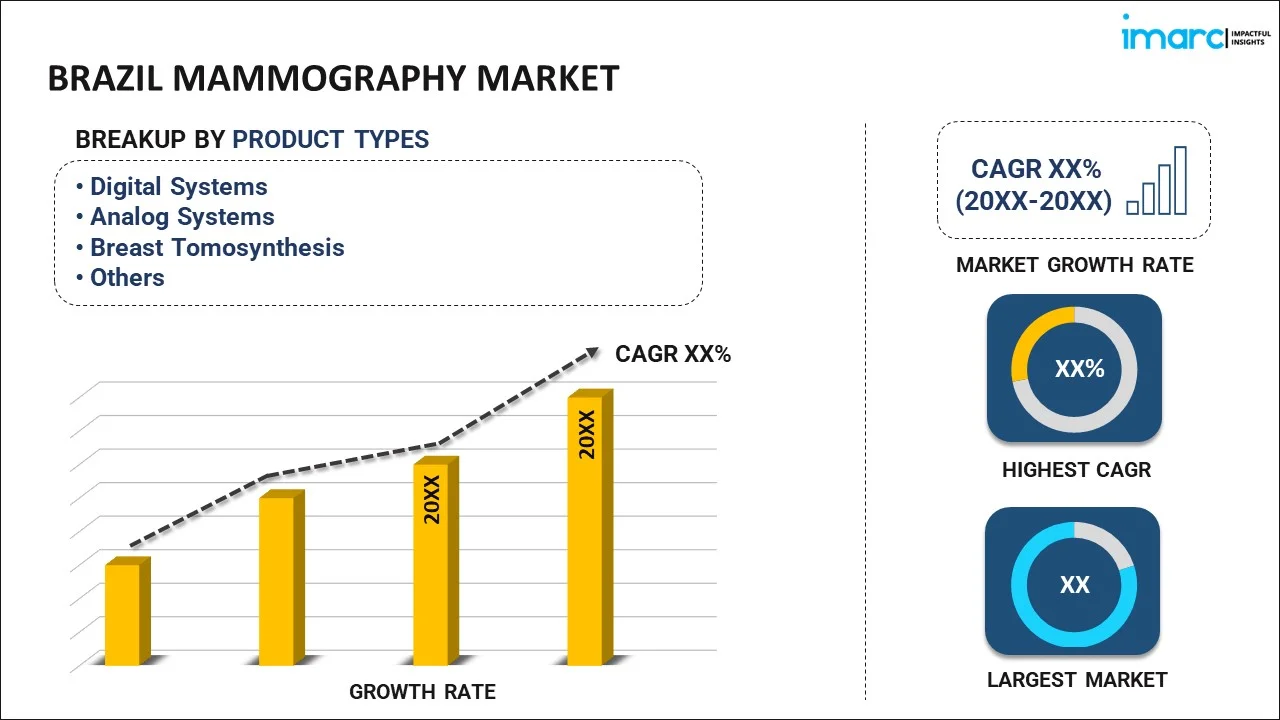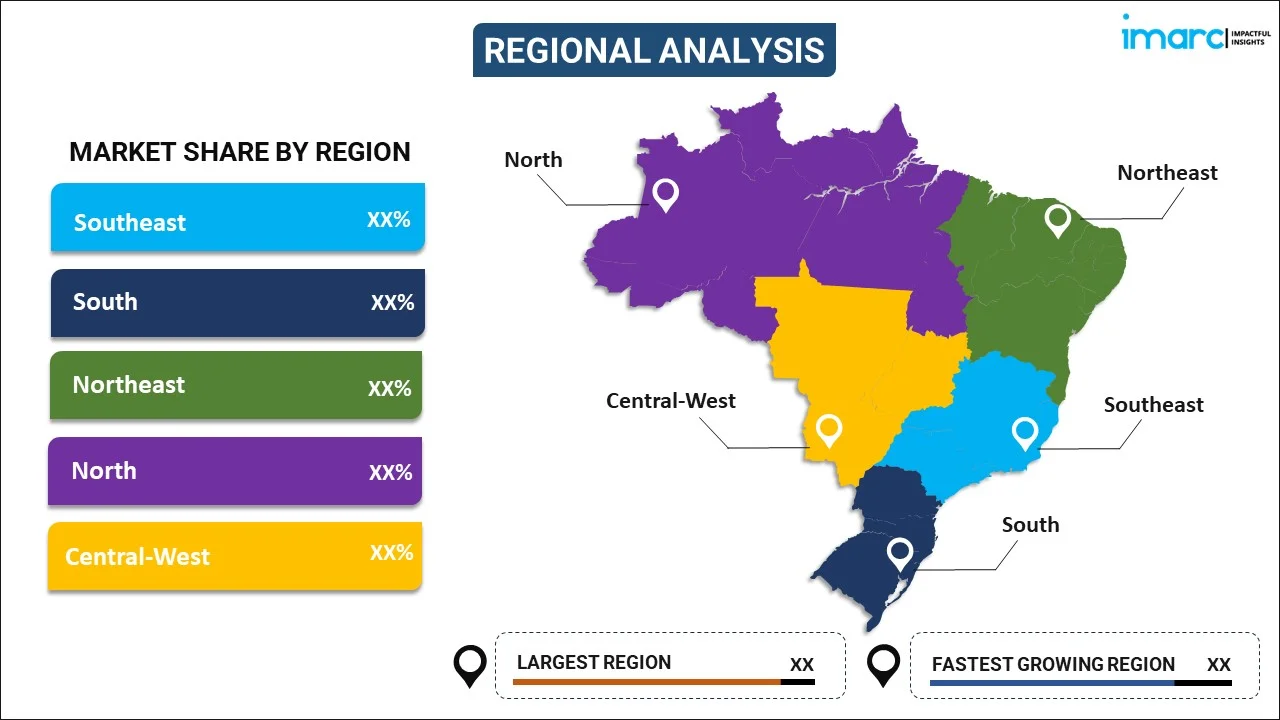
Brazil Mammography Market Report by Product Type (Digital Systems, Analog Systems, Breast Tomosynthesis, and Others), End User (Hospitals, Specialty Clinics, Diagnostic Centers), and Region 2025-2033
Market Overview:
Brazil mammography market size reached USD 46.7 Million in 2024. Looking forward, IMARC Group expects the market to reach USD 104.5 Million by 2033, exhibiting a growth rate (CAGR) of 9.2% during 2025-2033. The escalating prevalence of breast cancer in Brazil, heightened awareness about breast cancer screening and early diagnosis, recent advancements in mammography technologies, increasing investment in healthcare by government and private organizations, and rapid expansion of healthcare infrastructure, represent some of the key factors driving the market.
|
Report Attribute
|
Key Statistics
|
|---|---|
|
Base Year
|
2024
|
|
Forecast Years
|
2025-2033
|
|
Historical Years
|
2019-2024
|
|
Market Size in 2024
|
USD 46.7 Million |
|
Market Forecast in 2033
|
USD 104.5 Million |
| Market Growth Rate 2025-2033 | 9.2% |
Mammography refers to a specialized medical imaging technique that employs low-dose X-rays to examine the human breast for the early detection of cancer and other abnormalities. It is comprised of several components, such as collimators, compression paddles, and image receptors that are made from high-quality materials like metal alloys and specialized plastics to ensure durability and precision. Mammography finds applications in various areas, such as screening, diagnostic follow-up, monitoring the efficacy of treatments, biopsy guidance, and preoperative mapping. It is indispensable in healthcare for its ability to provide early cancer detection, improved survival rates, low radiation exposure, cost-effectiveness, rapid imaging process, and suitability for dense breast tissue. In addition, mammography offers several advantages, such as high sensitivity, specificity, and the capability to distinguish between benign and malignant masses, thereby playing a pivotal role in patient management strategies.
Brazil Mammography Market Trends:
The escalating prevalence of breast cancer in Brazil, which is facilitating the adoption of early detection techniques like mammography, is propelling the market growth. Furthermore, heightened awareness about breast cancer screening and early diagnosis to prevent future complications, reduce healthcare expenditure, and improve clinical outcomes is catalyzing the market growth. In addition to this, the recent advancements in mammography technologies, such as three-dimensional (3D) mammography and artificial intelligence (AI)-based image analysis, that are broadening the scope of the procedure, are contributing to the market growth. Besides this, the increasing investment in healthcare by the government and private organizations to establish modernized facilities and ensure access to state-of-the-art technologies for patients is supporting the market growth. Additionally, the rapid expansion of healthcare infrastructure, coupled with the widespread availability of skilled radiologists in Brazil, is positively impacting the market growth. Moreover, the integration of telehealth technologies for remote mammogram readings, which enhances patient convenience and reduces healthcare expenditure, is strengthening the market growth. Along with this, the escalating geriatric population in Brazil, which is highly vulnerable to breast cancer is acting as another growth-inducing factor. Apart from this, the widespread organization of campaigns and educational programs by government and private players to raise awareness regarding breast cancer and the benefits of mammography techniques is catalyzing the market growth. Furthermore, the recent development of portable mammography units, which increases accessibility and improves efficiency, is strengthening the market growth. Besides this, the rising collaborations among hospitals and diagnostic centers, which facilitate the availability of advanced mammography services, are accelerating the market growth. Moreover, the implementation of favorable reimbursement policies encouraging more people to undergo screenings is stimulating the market growth.
Brazil Mammography Market Segmentation:
IMARC Group provides an analysis of the key trends in each segment of the market, along with forecasts at the country level for 2025-2033. Our report has categorized the market based on product type and end user.
Product Type Insights:

- Digital Systems
- Analog Systems
- Breast Tomosynthesis
- Others
The report has provided a detailed breakup and analysis of the market based on the product type. This includes digital systems, analog systems, breast tomosynthesis, and others.
End User Insights:
- Hospitals
- Specialty Clinics
- Diagnostic Centers
A detailed breakup and analysis of the market based on the end user have also been provided in the report. This includes hospitals, specialty clinics, and diagnostic centers.
Regional Insights:

- Southeast
- South
- Northeast
- North
- Central-West
The report has also provided a comprehensive analysis of all the major regional markets, which include Southeast, South, Northeast, North, and Central-West.
Competitive Landscape:
The market research report has also provided a comprehensive analysis of the competitive landscape in the market. Competitive analysis such as market structure, key player positioning, top winning strategies, competitive dashboard, and company evaluation quadrant has been covered in the report. Also, detailed profiles of all major companies have been provided.
Brazil Mammography Market Report Coverage:
| Report Features | Details |
|---|---|
| Base Year of the Analysis | 2024 |
| Historical Period | 2019-2024 |
| Forecast Period | 2025-2033 |
| Units | Million USD |
| Scope of the Report | Exploration of Historical and Forecast Trends, Industry Catalysts and Challenges, Segment-Wise Historical and Predictive Market Assessment:
|
| Product Types Covered | Digital Systems, Analog Systems, Breast Tomosynthesis, Others |
| End Users Covered | Hospitals, Specialty Clinics, Diagnostic Centers |
| Regions Covered | Southeast, South, Northeast, North, Central-West |
| Customization Scope | 10% Free Customization |
| Post-Sale Analyst Support | 10-12 Weeks |
| Delivery Format | PDF and Excel through Email (We can also provide the editable version of the report in PPT/Word format on special request) |
Key Questions Answered in This Report:
- How has the Brazil mammography market performed so far and how will it perform in the coming years?
- What has been the impact of COVID-19 on the Brazil mammography market?
- What is the breakup of the Brazil mammography market on the basis of product type?
- What is the breakup of the Brazil mammography market on the basis of end user?
- What are the various stages in the value chain of the Brazil mammography market?
- What are the key driving factors and challenges in the Brazil mammography?
- What is the structure of the Brazil mammography market and who are the key players?
- What is the degree of competition in the Brazil mammography market?
Key Benefits for Stakeholders:
- IMARC’s industry report offers a comprehensive quantitative analysis of various market segments, historical and current market trends, market forecasts, and dynamics of the Brazil mammography market from 2019-2033.
- The research report provides the latest information on the market drivers, challenges, and opportunities in the Brazil mammography market.
- Porter's five forces analysis assist stakeholders in assessing the impact of new entrants, competitive rivalry, supplier power, buyer power, and the threat of substitution. It helps stakeholders to analyze the level of competition within the Brazil mammography industry and its attractiveness.
- Competitive landscape allows stakeholders to understand their competitive environment and provides an insight into the current positions of key players in the market.
Need more help?
- Speak to our experienced analysts for insights on the current market scenarios.
- Include additional segments and countries to customize the report as per your requirement.
- Gain an unparalleled competitive advantage in your domain by understanding how to utilize the report and positively impacting your operations and revenue.
- For further assistance, please connect with our analysts.
 Inquire Before Buying
Inquire Before Buying
 Speak to an Analyst
Speak to an Analyst
 Request Brochure
Request Brochure
 Request Customization
Request Customization




.webp)




.webp)












